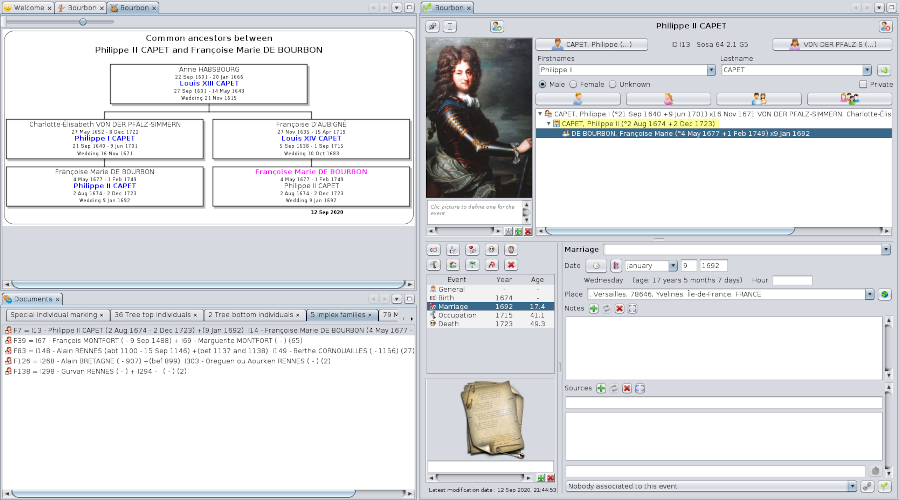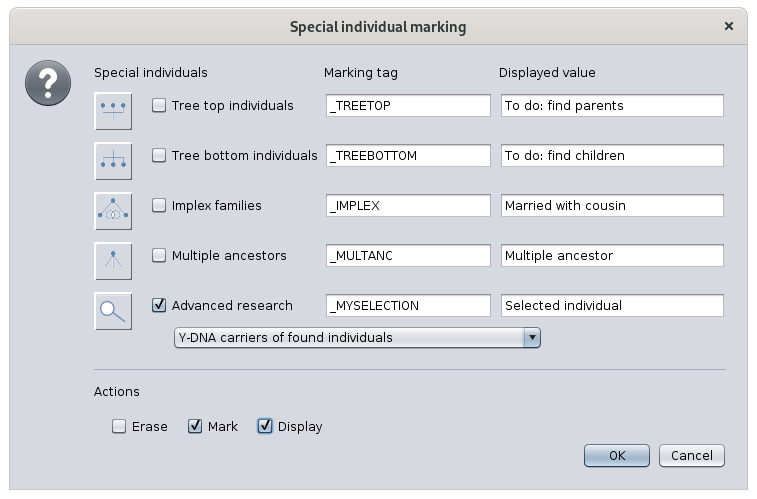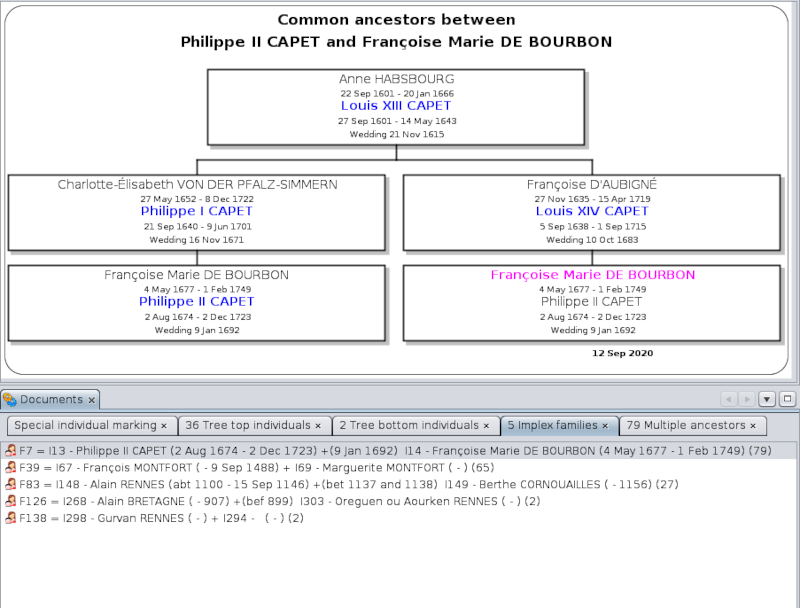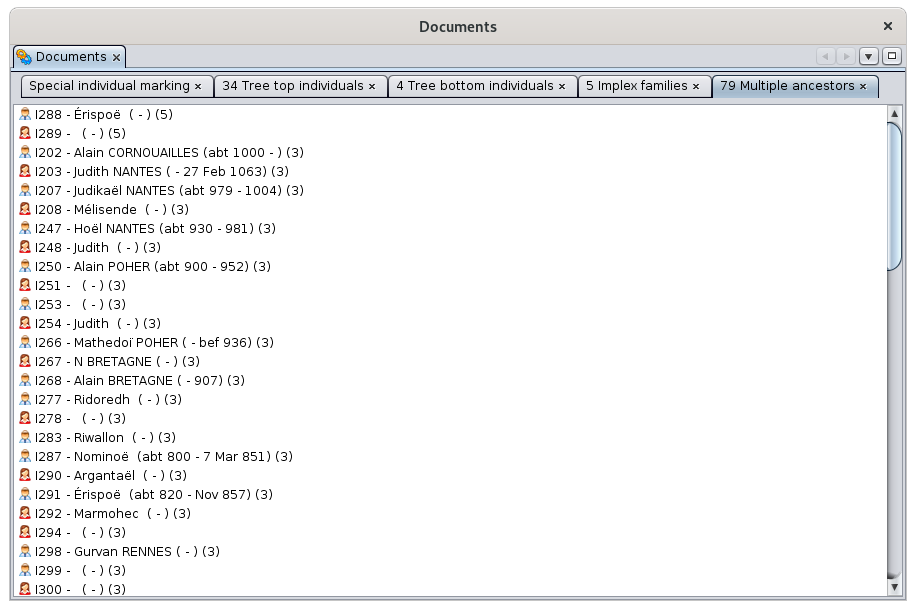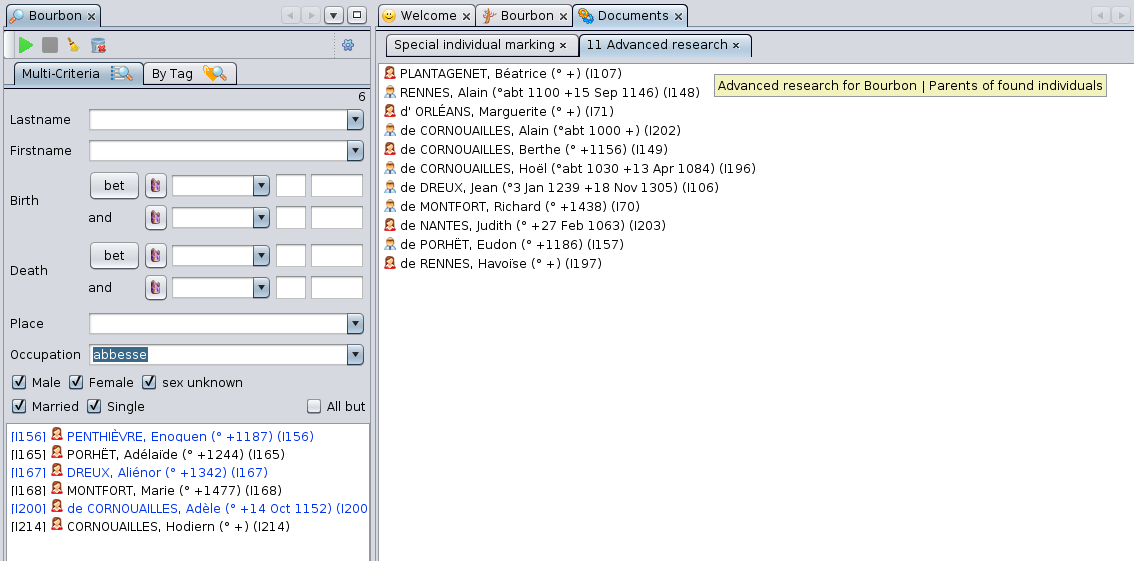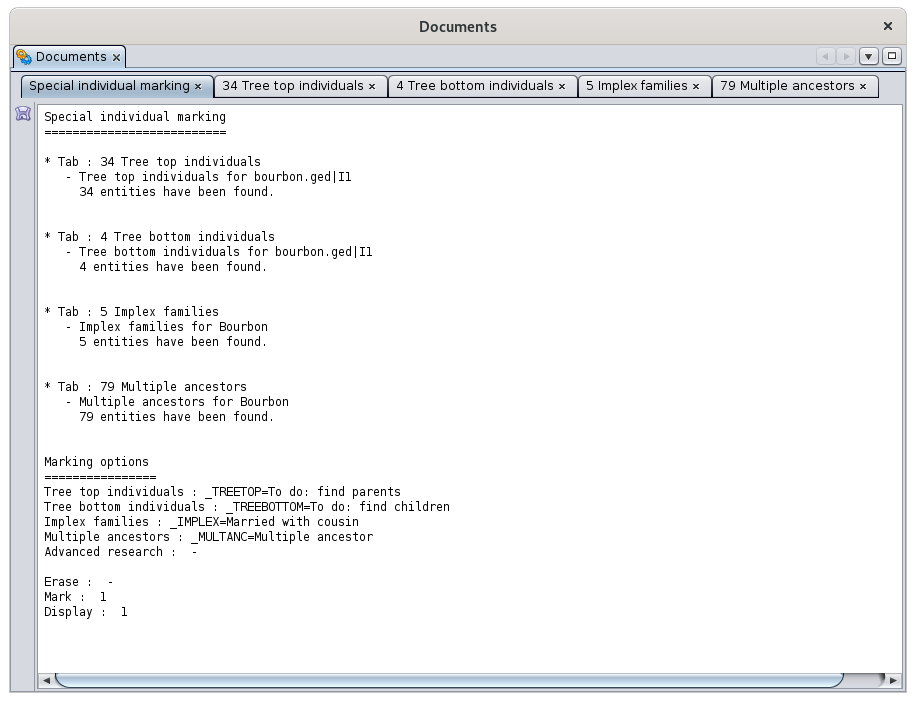Marcar individuos especiales
Esta característica marca o muestra ciertos individuos especiales en su genealogía, como familias implex, individuos de la parte alta de los árboles, personas relacionadas con el ADN-Y, etc.
Descripción
En Ancestris, hemos identificado varios tipos de poblaciones en su genealogía que podrían ser de gran interés para usted. Se enumeran en esta ventana y se describen a continuación.
- Individuos en la parte alta del árbol: estos son los individuos sin progenitores en la parte superior del árbol ascendente de un individuo raíz dado tomado como De Cujus.
- Individuos en la base del árbol: por el contrario, estos son los individuos sin hijos en la base del árbol que descienden de un individuo raíz tomado como punto de partida. Pueden ser solteros o casados, y no tienen descendiente registrado.
- Familias complejas: son "parejas de primos", es decir, individuos que forman una unión y tienen al menos un antepasado común. Su unión genera el implex, es decir una reducción en el número de ascendientes de sus descendientes. Pueden o no tener hijos identificados en la genealogía.
- Ascendientes múltiples: son los individuos que tienen familias implex entre sus descendientes. Cada antepasado múltiple puede ser un antepasado múltiple de diferentes parejas.
- Búsqueda avanzada: son los individuos encontrados y resultantes de la Búsqueda avanzada, o personas relacionadas con ellos de determinada manera. Por lo tanto podemos optar por marcar:
- los propios individuos encontrados
- los progenitores de los individuos encontrados
- los hijos/as de los individuos encontrados
- los cónyuges de las personas encontradas
- los antepasados de los individuos encontrados
- los descendientes de los individuos encontrados
- los portadores del ADN-Y de los individuos encontrados
- los portadores del mt-DNA de los individuos encontrados
- los portadores potenciales de un cromosoma X de los individuos encontrados
Para cada una de estas poblaciones, Ancestris le permite definir una etiqueta definida por el usuario para marcarlas y encontrarlas más fácilmente más tarde, por ejemplo, en la propia vista de búsqueda avanzada. Puedes nombrar la etiqueta como quieras. Ancestris se asegurará de que comience con el carácter '_'.
Ancestris también le permite definir el valor de esa etiqueta. La pantalla anterior sugiere posibles etiquetas y valores.
Finalmente, las casillas de verificación en la parte inferior de la ventana le permiten elegir borrar, marcar o mostrar solo las personas correspondientes.
Una vez que las personas están marcadas, puede ver las etiquetas en el editor Gedcom.
Uso
Marcar individuos puede ser muy útil para ubicar fácilmente a los individuos y hacer algunos análisis.
Los individuos de la parte superior del árbol y los individuos de la parte inferior del árbol representan el perímetro exterior de su progreso genealógico en términos de individuos.
- Los individuos de la parte superior del árbol son aquellos desde donde busca antepasados.
- Los individuos de la base del árbol son aquellos desde donde buscas descendientes.
Las familias implex y los antepasados múltiples proporcionan una mejor comprensión de las filiaciones en su genealogía.
Como se puede ver en el siguiente ejemplo, Ancestris resalta rápidamente las parejas implex en la genealogía y sus relaciones a través de antepasados comunes, gracias a esta herramienta combinada con la herramienta Antepasados comunes.
También puede ver 5 pestañas en la ventana Documentos. El primero, "Marcado individual especial" es un resumen de lo que se encontró y marcó. Cada una de las otras pestañas corresponde a una población individual especial.
Para llegar allí, primero hemos seleccionado un individuo en la genealogía. Luego abrimos esta herramienta de "marcar individuo especial" desde el menú Editar, luego verificamos las poblaciones que nos interesaban, completamos las etiquetas y los valores que queríamos, y finalmente presionamos OK.
La elección de un individuo de referencia solo es útil para los individuos de la parte superior e inferior del árbol. Para implexes y antepasados múltiples, Ancestris busca en toda la genealogía.
For each of the special populations, Ancestris creates a tab in the Documents window.
What follows is a description of each population marking.
Tree top individuals
In the case of the Bourbon file used here, we asked for the marking and display of the top individuals after first selecting the individual Louis XIII.
Ancestris found 34 tree top individuals in the ascendant tree of Louis XIII. These individuals are listed in the tab. Just click on them to display them in the views of Ancestris.
Each individual name is preceded by a Sosa number generated for the occasion, but not stored in the genealogy. This number is constructed like the other Sosa numbers in Ancestris, that is to say with the generation number and the Sosa number itself.
The list is sorted in ascending order of Sosa number.
By clicking on one of the individuals and viewing it in the Gedcom editor, we see that the _TREETOP label has been added.
Tree Bottom Individuals
In the case of the Bourbon file used here, we requested the marking and display of tree bottom individuals by first seleccting Louis XIII.
Ancestris found 4 individuals at the bottom of Louis XII descending tree. These individuals are listed in the tab. Just click on them to display them in the views of Ancestris.
Each individual name is preceded by a d'Aboville number generated for the occasion, but not kept in Gedcom. This number is constructed like the other Ancestris d'Aboville numbers, that is to say with the generation number and the actual d'Aboville number.
The list is sorted in ascending order of d'Aboville number.
By clicking on one of the individuals and viewing it in the Gedcom editor, we see that the _TREEBOTTOM tag has been added.
For tree bottom individuals who belong to families without children, the family ID is added to the value of the tag, to make it easy for you to identify the family from the individual.
Implex families
In the case of the Bourbon file used here, we requested the marking and display of the implex families. This marking does not require specifying a reference individual. The result of the marking tool is the same regardless of which individual is selected.
Ancestris found 5 implex families in the entire Bourbon genealogy provided. These families are listed in the tab. Just click on them to display them in the views of Ancestris.
Each family name is followed by a number between parentheses. This is the number of common ancestors to both members of the couple. Note that these individuals will be themselves in the Multiple Ancestors tab !
The list is sorted in descending order of the number of common ancestors.
By clicking on one of the families, the Common Ancestors viewing window appears and shows the visual path between one of the common ancestors and the two members of the couple.
In the Gedcom editor, we see that the _IMPLEX tag has been added to the family, suffixed with the numbr of common ancestors.
Multiple ancestors
In the case of the Bourbon file used here, we requested the marking and display of multiple ancestors. This marking does not require to first select a reference individual.
Ancestris found 79 multiple ancestors throughout the Bourbon genealogy provided by Ancestris. These individuals are listed in the tab. Just click on them to display them in the views of Ancestris.
Each individual name is followed by a number in parentheses. This is the number of couples among its descendants who are implex families. Note that these families will be in the previous Implex families tab.
The list is sorted in descending order of the number of these implex families.
Clicking on one of the individuals displays it in the views of Ancestris. In the Gedcom editor, we see that the _MULTANC tag has been added to the individual, followed by the list of all the descending implex families.
Multiple ancestors are displayed in black if they are related to the current De Cujus of the genealogy - that is to say, they hold a _SOSA or _SOSADABOVILLE tag, or they are displayed in purple otherwise.
Advanced search
In the case of the Bourbon file used here, we asked for the marking of the parents of individuals who had an occupation of Abbess.
In the Advanced search, we have selected the Abbesses individuals. Then in the marking tool, we have checked Advanced search and chose the relation "Parents of individuals found" in the dropdown list.
Ancestris found 6 abbesses in the Advanced search, who have together 11 parents as we can see in the marking tools.
The individuals are sorted in alphabetical order.
Clicking on one of the individuals displays it in the views of Ancestris. In the Gedcom editor, we see that the _MYSELECTION tag has been added to the individual, followed by the value defined.
Special individual marking tab
In order for you to know the marking request you did, the first tab generated is a summary of your request and the list of results.
Customization
There is no specific customization for this tool.

